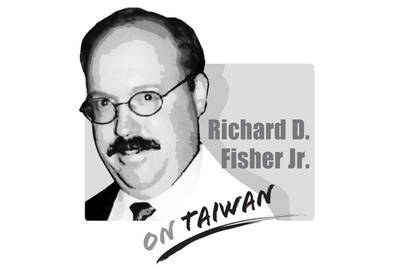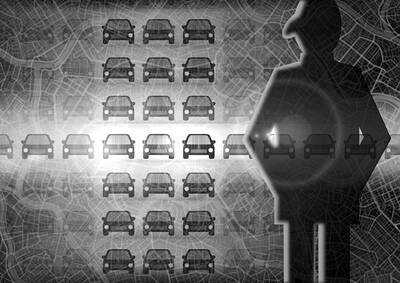Staring up from the bottom of the deepest pipe in the world’s most ambitious plumbing operation, the view is that of a frog in a well: a small distant disc of sky. Look again two years from now, and you would see a torrent of water apparently defying gravity as it surges up the 39m shaft first toward the heavens, then to Beijing and other thirsty cities.
The Guardian was the first foreign news organization to enter the pits and tunnels at Jiaozuo in Henan Province, which are at the center of China’s latest, greatest engineering project, the South-North Water Diversion Scheme. In the spirit of Chinese President Hu Jintao’s (胡錦濤) drive for “scientific development,” the aim is to engineer a solution to the most pressing environmental problem — the alarming depletion of water resources in the arid, heavily populated north.
More than twice as expensive as the Three Gorges Dam and three times longer than the railway to Tibet, the 50-year, US$62 billion project aims to channel a greater volume than the Thames along three channels — each more than 1,000km long — from the moist Yangtze basin up to the dry lands above the Yellow river.
At Jiaozuo, giant drills have already gouged out more than half of the 4km-long tunnel that will take the water under the Yellow river. At the foot of the construction shaft, the 9m-wide concrete pipe stretches into the dark far below the farm fields that stretch toward the river.
“This is a first in the history of the Yellow,” one of the engineers, Han Jiping, says proudly. “There is nothing to compare.”
The project has sparked so many ecological, financial and political concerns that government advisers are calling for the plan to be delayed and possibly curtailed, raising the possibility that this could prove a mega-project too far even for China. First proposed in 1962, the scheme was approved by Mao Zedong (毛澤東), who said it was fine for the south to “lend a little water,” but until recently the government has not had the money or technical ability to go ahead.
In the north, the disparity between supply and demand is evident across swaths of land that rely on the overworked and heavily polluted Yellow River. China’s second-biggest river accounts for 2 percent of the country’s run-off, yet irrigates 15 percent of the crops and supplies water to 140 million people, about 12 percent of the population.
Xinhua news agency reported last year that 4 billion tonnes of industrial waste and sewage were discharged annually into the river system, leaving 83 percent of the water too contaminated to drink without treatment.
Tang Xiyang, one of the founders of the green movement in China, is apocalyptic: “The Yellow river civilization has been destroyed. People cannot survive on that river any more.”
Yet the pressure on China’s “Mother River” grows as industrial parks and cities expand. The accumulated overuse of water in the Beijing, Tianjin and Hebei areas of northern China is estimated at 9 billion cubic meters. Water tables are falling and lakes evaporating.
Reducing demand has been difficult. At the control center of the Yellow River Conservancy Commission in Zhengzhou, water allocations are displayed on a wall-sized screen. Nine provinces share the water. Proportions have been fixed since 1987 based on an over-optimistic estimate that annual run-off is 58 billion cubic meters. This year, the volume is forecast to be less than 50 billion cubic meters. In 2003, it fell below 45 billion. Provinces are supposed to equally share the shortfall. Yet Ningxia, Inner Mongolia and Shandong take more than 1 billion cubic meters of water above allocation every year without permission.
The loser is the ecosystem. Twenty-one billion cubic meters are set aside for sediment flushing and maintenance of non-human life on the river. This is the area of the water budget that is raided when provinces go over their limit. Research shows the value of keeping water for nature, but officials say they need more power to achieve this.
“Some provinces and reservoirs don’t obey our instructions. They ignore us to generate electricity,” Yu says. “It’s a problem. We lack punitive measures.”
The commission has reduced flooding and sedimentation and says pollution has peaked in several areas. But regulation of demand remains a challenge.
The central government is drafting a Yellow River law that will give more power to the river’s administrators. There are plans for a “digital Yellow River” scheme for officials in Zhengzhou to remotely control and monitor sluice gates and irrigation channels along the river — today only possible in the lower reaches.
This demand-side solution faces fierce opposition. No province wants a cut in water supplies when they all want to boost industry and agriculture. The latter is the biggest drain on the river, accounting for 90 percent of diverted water. Yu and his colleagues are dispatched to sluice gates during times of drought.
“It can be very dangerous,” he says. “In the past, our engineers have been thrown into the river by angry residents. In the early days after 1999, nobody wanted to accept us. Upstream residents didn’t care about lowstream demands. They said that historically, they could always take what they wanted.”
Faced by such obstacles in reducing demand, the government is pressing ahead with measures to increase supply. Its main response is the diversion scheme, approved by Hu — a hydro-engineering graduate — in 2002.
A year after the first leg was supposed to be complete, all three routes have hit snags. The eastern leg, along the Grand Canal, was supposed to be the easiest to finish, but pollution in this heavily industrialized region is so great that water treatment is prohibitively expensive.
The western leg has been suspended over concerns about the political and economic cost of diverting water from the Yangtze to the Yellow, high on the Tibet-Qinghai plateau. The central route also faces delays over environmental and compensation concerns. About 300,000 people will have to be relocated and swaths of farmland cleared.
At Jiaozuo, a 40-minute drive north of Zhengzhou, engineers from the 16th Bureau of the China Railway Construction Group are digging a 40m-wide channel through the red earth. Once completed, it will take 9.5 billion cubic meters of water from the Han River, which feeds the Yangtze, to Beijing — but it will leave problems at its source.
Du Yun, a geologist at the China Academy of Sciences, has warned that the diversion of a third of the water in the Danjiangkou Reservoir will raise the risk of pollution, sedimentation and flooding on the Han River.
To offset these fears, the government has earmarked an extra 8 billion yuan (US$1.4 billion) to bolster the Han, including diverting water from the Three Gorges reservoir on the Yangtze and along the Xinglong Hinge. These measures — essentially robbing Peter to pay Paul — will require at least 650km of channels to be dug through farmland.
“We are appealing for the government to increase the compensation fund for Han River projects and to build more sewage plants,” said Shen Xiaoli (沈曉鯉), of the Research Academy of Environmental Science in Hubei. “Once a construction project starts upstream, it requires water compensation downstream. This, in turn, necessitates other projects to deal with the negative impacts. It’s a circle in which you need ever more solutions and ever more funds.”
Most of the grumbles are coming from the middle reaches of the Han.
“Local people are very worried about the impact on our ecology because we will lose a fifth of our water,” said a resident of Xiangfan City, who asked to remain anonymous. “Although we are concerned, everyone must express support. We dare not oppose the central government.”
Yet, this is only the first of three-planned phases of construction on the east and central legs. The government has been advised to wait and see the results before proceeding further.
“The original plans were made 20 years ago. Since then our society has developed and the natural environment has changed. My view is that we must make a new assessment of the plan for the middle and eastern legs,” a senior government adviser said. “Then we should decide whether we need changes, whether we should go ahead with the second and third stages.”
The comments are part of a debate about the wisdom of nature-conquering mega-projects. The new scientific development aims at sustainability.
“I am not a supporter of mega-projects,” said Zuo Qiting (左其亭), a professor of hydrology at Zhengzhou University. “One way to halt the trend of ever-bigger projects is to evaluate their impact from a wider perspective. We need to look not just locally, but at the national and global level.”
International environmental groups say the focus should be on reducing demand.
“Transferring water from the Yangtze tributaries to the thirsty plains of northern China may well lead to environmental collapse of the Han river, the Three Gorges wreservoir and the Yangtze delta,” said Peter Bosshard of International Rivers. “To resolve its water crisis, China needs to phase out thirsty industries and agricultural crops in the drought-prone north and replace them with more environmentally sound practices.”
Concerns that the US might abandon Taiwan are often overstated. While US President Donald Trump’s handling of Ukraine raised unease in Taiwan, it is crucial to recognize that Taiwan is not Ukraine. Under Trump, the US views Ukraine largely as a European problem, whereas the Indo-Pacific region remains its primary geopolitical focus. Taipei holds immense strategic value for Washington and is unlikely to be treated as a bargaining chip in US-China relations. Trump’s vision of “making America great again” would be directly undermined by any move to abandon Taiwan. Despite the rhetoric of “America First,” the Trump administration understands the necessity of

US President Donald Trump’s challenge to domestic American economic-political priorities, and abroad to the global balance of power, are not a threat to the security of Taiwan. Trump’s success can go far to contain the real threat — the Chinese Communist Party’s (CCP) surge to hegemony — while offering expanded defensive opportunities for Taiwan. In a stunning affirmation of the CCP policy of “forceful reunification,” an obscene euphemism for the invasion of Taiwan and the destruction of its democracy, on March 13, 2024, the People’s Liberation Army’s (PLA) used Chinese social media platforms to show the first-time linkage of three new

If you had a vision of the future where China did not dominate the global car industry, you can kiss those dreams goodbye. That is because US President Donald Trump’s promised 25 percent tariff on auto imports takes an ax to the only bits of the emerging electric vehicle (EV) supply chain that are not already dominated by Beijing. The biggest losers when the levies take effect this week would be Japan and South Korea. They account for one-third of the cars imported into the US, and as much as two-thirds of those imported from outside North America. (Mexico and Canada, while
The military is conducting its annual Han Kuang exercises in phases. The minister of national defense recently said that this year’s scenarios would simulate defending the nation against possible actions the Chinese People’s Liberation Army (PLA) might take in an invasion of Taiwan, making the threat of a speculated Chinese invasion in 2027 a heated agenda item again. That year, also referred to as the “Davidson window,” is named after then-US Indo-Pacific Command Admiral Philip Davidson, who in 2021 warned that Chinese President Xi Jinping (習近平) had instructed the PLA to be ready to invade Taiwan by 2027. Xi in 2017